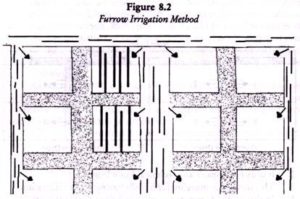Furrow irrigation method is resorted to where crops are one grown in rows. Along the side of rows of crops, ‘Dol’is formed, and in between two such ‘Dols’, a furrow is formed in which water flows for irrigation. The quantity of flow of water depends on demand of water by plants and the rate of infiltration.

In different situations, different furrow methods are used (Surajbhan 1978). They are mainly of five types:
1. Slopy Furrow
2. Leveled Furrow
3. Contour Furrow
4. Serial Furrow
5. Corrugated Furrow
Advantages:
1. Large areas can be irrigated at a time.
2. It saves labour since once the furrow is filled, it is not necessary to give water a second time.
3. It is a comparatively cheaper method.
4. Plants gets suitable quantity of water by this method.
Disadvantages:
1. Due to imbalance in flow of water, wastage of water is caused in it.
2. It is not suitable in all types of crops.
3. Making ‘Dol’ for drains requires more labour information.
4. Due to filling of excess water, there is risk of underground salts coming up to the surface layer.
